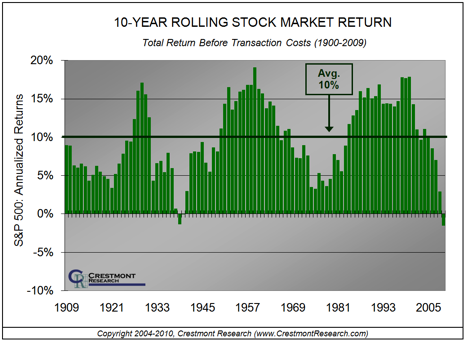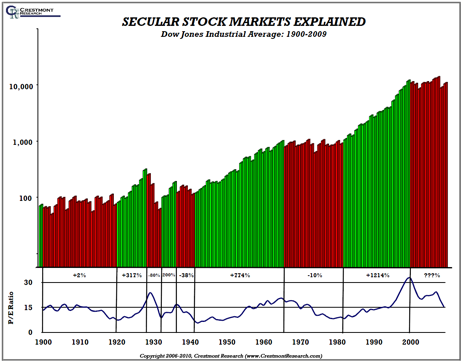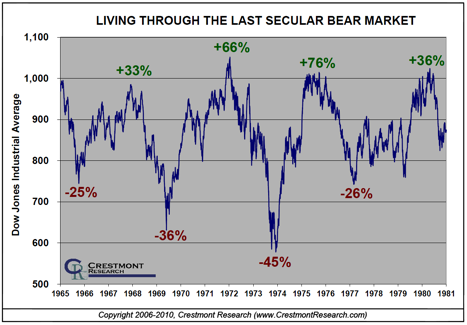Although the weather can seem fairly random from day to day, the weekly and monthly patterns are driven by the overriding impact of the seasons. Likewise, the stock market has long-term “secular” cycles driven by the fundamentals of finance and short-term “cyclical” cycles within these secular cycles.
Because the market movements often appear random, conventional wisdom assumes a random walk for the market.
Yet conventional wisdom too often includes shortcuts that create blinders to insight. Whether you invest or trade, an understanding of the cycles and their implications can be invaluable toward financial success.
Secular Cycles
Secular stock market cycles are extended periods of above-average returns (secular bull markets) and below-average returns (secular bear markets). Just like seasons of the weather, these secular cycles are not coincidental patterns or long-term phenomena; rather, these periods are caused by fundamental drivers of returns.
Why does this matter to a trader or investor? An understanding of the patterns and drivers can greatly enhance success in the market. The market is not a random pattern of results or a simple game of chance, such as flipping a coin or spinning the roulette wheel.
In games of chance, the odds are known and are unaffected by previous events or current conditions.
The market more closely relates to a game of skill, where past events and current conditions actually affect future results. This article should help you to “count the cards” in the market to know when it is winter or summer and to know when to fade a winter warm spell or lean into the emerging spring.
Fundamental Drivers
If returns in the market were occurring randomly over time, then 10-year periods in the stock market would presumably show relatively random results. However, Figure 1 presents quite a different pattern.
It undulates from below-average to above-average. The chart reflects all 10-year periods since 1900: the first is 1900 to 1909, then 1901 to 1910 and so on. Each bar is the average compounded return including dividends during every 10-year period since 1900. The pattern clearly is not random, and it is driven primarily by the significant factor of market valuation.
Figure 1. S&P 500 Index Total Returns By Decades

Key Components
To understand a multifaceted situation, it is sometimes helpful to break it into the component parts. Stock market returns consist of three parts: earnings growth, dividend yield and the change in the price-to-earnings ratio (P/E).
The growth of earnings represents the core driver of stock market appreciation. As the earnings of companies increase over time, the value of companies tends to increase. If P/E (the valuation multiple of the market) stays the same, then the stock price (or overall market) will increase consistently with earnings growth.
But the stock market often increases by more than earnings growth or, at times, declines despite earnings growth. In these instances, respectively, earnings growth is multiplied by an increase in P/E or offset by a decrease in P/E.
The Big Picture
The price/earnings ratio for the overall market is developed by dividing a price index by the aggregate earnings of companies in the index. P/E is a valuation multiple because it essentially reflects the number of years worth of earnings that investors will pay today for a future stream of income from stocks.
When inflation and interest rates are high, investors want higher returns, so they pay a lower price upfront for stocks. When deflation occurs, future income and dividends reflect a declining deflationary trend, so investors pay lower prices here, too.
Only in conditions when inflation is low and stable do investors pay higher P/Es for stocks. Therefore, trends in inflation or deflation drive P/Es through a cycle of higher and lower levels.
Because P/E is a multiplier of earnings growth, a rising trend in P/E can often double or triple the level of return from earnings growth. A declining trend in P/E, however, can offset some or all of the benefit from earnings growth.
Beyond the return that is driven by earnings growth and the change in P/E, an investor also receives dividends from a portfolio of stocks. So dividends add a final component to the total return from the stock market.
What’s the Cycle?
The key point, as detailed in the book Unexpected Returns: Understanding Secular Stock Market Cycles, is to recognize that the cycle in P/E drives the secular stock market cycles. As earnings tend to grow over time, a rising P/E will multiply earnings growth and drive above-average returns. A decline in P/E will offset earnings growth and deliver below-average returns.
The impact of the price/earnings ratio on the stock market is reflected in Figure 2. The red and green bars represent the year-end level of the market; the colors of the bars represent secular bear and secular bull cycles, respectively. The blue line on the bottom of the graph is P/E. As it rises, we experience green-bar, secular bull market periods. As P/E falls, we experience red-bar, secular bear market periods.
Figure 2. Secular Stock Market Cycles Explained

Most noteworthy, the pattern of P/E is not random…and the red-bar and green-bar periods are not random.
The price pattern for secular bull markets is a generally rising stock market driven by an increase in earnings and an increase in P/Es. The price pattern for secular bear markets is a generally choppy stock market driven by an increase in earnings and a decrease in P/Es.
Implications for Trading
For long-term investors, a multi-year and multi-decade perspective is often sufficient, especially when the environment is a green-bar, secular bull market. But for traders and curious investors, a look inside a typical secular bear market can be revealing.
For example, although the Himalaya Mountains may appear to be little hills from an airplane flying over them, the terrain is quite different for someone taking each step on the ground.
The red-bar, secular bear market of the 1960s and 1970s in Figure 2 appears muted across a century of time. Yet the daily, trail-worn path “feels” quite different.
Another View
Figure 3 reflects the dramatic short-term cyclical bull and bear cycles that occur throughout the longer secular bear market period. The magnitude of the swings, presented as percentages between peaks and troughs, is much more significant than most people expect.
Figure 3. Living Through The Last Secular Bear Market

Additionally, the relatively short periods for the cyclical bulls and bears further multiplies the drama.
The investment approach employed not only by investors, but also particularly by traders, should adjust to the different conditions of secular bulls and secular bears.
Whether your strategy is long- or short-biased, each of the secular market animals presents a unique environment of challenges and opportunities. Secular bear markets, with their repeatedly changing and erratic short-term cycles, pose especially challenging conditions. However, one trader’s challenge is another’s opportunity.
Outlook for the Next Few Years
In chapter five of Reminiscences of a Stock Operator by Edwin Lefèvre, the stalwart sage Mr. Partridge has a jousting exchange with investment newbie Elmer Harwood.
Harwood was focused only on the current stock trade; Partridge’s many years of experience taught him not to ignore the overall trend. Harwood would ultimately learn, while Partridge would profit.
The underlying conditions of the market were as relevant a century ago as they are today. But today, unlike the secular bull market of the 1920s, we are in the middle of a secular bear market that started in 2000.
For the remainder of this secular bear—which can be expected to last many more years—we can expect a couple or several years of surges punctuated by a year or two of decline.
While inflation remains relatively low and P/Es are commensurately high, the fundamentals are not in place to enable P/Es to double or triple to generate the next secular bull market.
The pattern will be frustrating for those who are not aware of it, yet rewarding for those who see the opportunities.
The secular bear roller coaster reflected in Figure 3 emphasizes the need to stay aware of the current normalized P/E. After the first quarter of 2010, P/E is in the lower end of the typical valuation range for relatively low inflation environments.
Crestmont Research updates quarterly, or more often as warranted, a complimentary assessment of the current state of P/E in the Stock Market section of its website. For now, the short-term cyclical bull has momentum; within quarters or years, another short-term bear will likely add another punctuation point to the current longer-term secular bear market.
The Seasons
For thousands of years, early man observed a pattern of seasons—from winter to spring, then on to summer, and concluding with fall. For many millenniums, seasons were a constant, though unexplained, pattern. At times, a warm day in the middle of winter would be confused with the beginning of spring. Farmers would run out and plant crops, only to be nipped by the continuation of winter.
Then about 500 years ago, astronomers determined that the tilt of the Earth caused the seasons. Suddenly they knew that summer cannot start in the middle of winter, no matter how long the warm spell persists. As a matter of fact, as the winter warm spell extends beyond a few days, the likelihood of a return to cold increases.
During winter, there are significant implications for farming. A few warm days are now known to be temporary, so savvy farmers know not to plant the summer crop too early. Most of all, success in these periods requires a more active, greenhouse approach or the planting of unique winter crops.
Be Nimble
During winter-like secular bear markets, investors and traders will not have the extended multi-year secular bull runs to rely upon. Market conditions will deliver intermittent, short-term cyclical bulls and bears, requiring a more nimble, hedged and actively managed approach to investing and trading.
